 Crossing Slippery Rock in the mountains above the Goleta Valley, along the original San Marcos Pass route over the Santa Ynez Mountains. The Pacific Ocean defines the horizon in the background. © Denver Public Library, Western History Collection
Crossing Slippery Rock in the mountains above the Goleta Valley, along the original San Marcos Pass route over the Santa Ynez Mountains. The Pacific Ocean defines the horizon in the background. © Denver Public Library, Western History Collection
“Santa Barbara lies on the seashore, and until lately it was isolated from the rest of the world by high mountains. No wagon road or stage route ran into it from without, only mere trails or paths for horses over the mountains. For a few years they had had a mail once in two weeks by steamer from San Francisco—two mails per month was the only news of the world outside.”
—William Brewer (1861)
“A ride on a frontier stage-coach was something to be remembered as a back-breaking, bone-twisting experience. ‘I felt like a mess of eggs being scrambled,’ one traveler described the trip. ‘I was bounced and tossed all over and despite our discomfort the driver never paid us any heed.’”
—James D. Horan & Paul Sann, Pictorial History of the Wild West (1954)
From 1861 to 1901 Santa Barbara was linked to the rest of California and the world by stagecoach. Evidence of the historic route leading upstate over the Santa Ynez Mountains can still be seen in a few locations. Along a thin, sandstone capped ridgeline in the mountains above Goleta, a section of the old road crosses an expanse of exposed bedrock. Tracks left behind by stagecoaches and horse drawn wagons and carriages remain worn into the sandstone some ten- to twelve-inches deep or more. The parallel grooves are remnants of the original San Marcos Pass route that was built by Chinese work crews using picks, shovels and wheelbarrows.
The ruts had originally been carved to a depth of about three inches in order to help guide horse drawn conveyances up the technical section of primitive roadway. Over the years the iron-capped wheels of stagecoaches ground the ruts ever deeper into the soft deposit of stone. Running between the ruts, horizontal grooves were chiseled to help horses maintain traction on the slippery surface as they hauled the heavy stages up the mountain. The exposed bedrock was notoriously slick beneath metal horseshoes and stagecoach wheels and was dubbed “Slippery Rock” or “Slippery Sal.”
The Slippery Rock route was closed sometime around 1892 after the owner of the property the road ran through, Tom Lillard, got tired of drivers leaving his gate open and cows straying. A new route was graded up a ridge to the east of Slippery Rock or what is today known as Old San Marcos Pass.
 Looking up Slippery Rock showing the two wheel tracks and the traction ruts carved horizontally across the wheel grooves.
Looking up Slippery Rock showing the two wheel tracks and the traction ruts carved horizontally across the wheel grooves.
 Looking down Slippery Rock. Two different sets of wheel ruts are visible here, along with the horizontal traction grooves for horses. Once the first set of wheel ruts became worn too deeply a new set was carved.
Looking down Slippery Rock. Two different sets of wheel ruts are visible here, along with the horizontal traction grooves for horses. Once the first set of wheel ruts became worn too deeply a new set was carved.
 A closeup view of the ruts and grooves.
A closeup view of the ruts and grooves.

 The narrow section of Slippery Rock, which is shown below in a photo from 2012 with live oak trees having grown in the middle of the old road. © Denver Public Library, Western History Collection
The narrow section of Slippery Rock, which is shown below in a photo from 2012 with live oak trees having grown in the middle of the old road. © Denver Public Library, Western History Collection

 Looking up the old road above Slippery Rock.
Looking up the old road above Slippery Rock. A narrow section of the road barely wide enough for a stagecoach to slip by pinched between a cliff on the left and and wall of stone on the right.
A narrow section of the road barely wide enough for a stagecoach to slip by pinched between a cliff on the left and and wall of stone on the right.


 State of the art suspension: rawhide straps.
State of the art suspension: rawhide straps.
 Both of these historic stagecoaches can be seen at the Santa Barbara Carriage and Western Art Museum. The yellow carriage was actually one of the last mudwagon stages in use over San Marcos Pass.
Both of these historic stagecoaches can be seen at the Santa Barbara Carriage and Western Art Museum. The yellow carriage was actually one of the last mudwagon stages in use over San Marcos Pass.
Reference:
-Charles Outland, Stagecoaching on El Camino Real: Los Angeles to San Francisco 1861-1901 (1973)
-Walker A. Tompkins, Stagecoach Days in Santa Barbara (1982)
Related Posts:
Through From Santa Barbara to San Francisco in 48 Hours (1873)
The Klutzy Career of Highwayman Dick Fellows (Stagecoach Robbery circa 1870s)







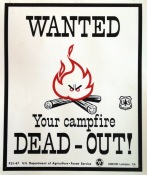

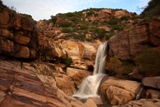
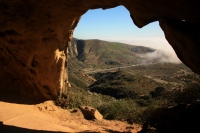

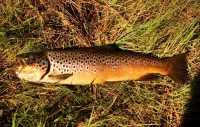
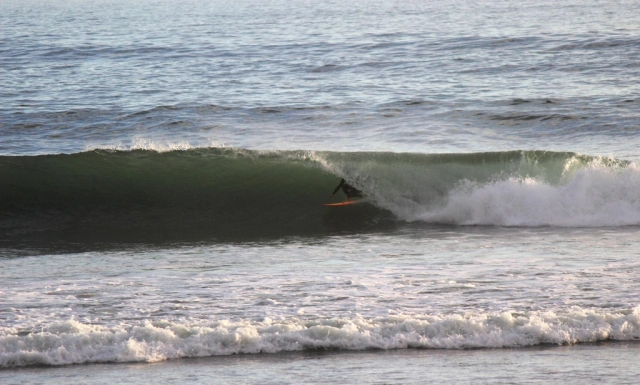
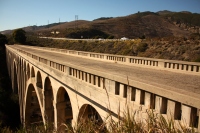
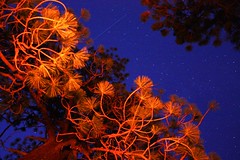








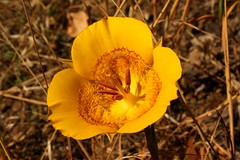









Super interesting – love it!
Great write-up and photos comparing the historic scenes to how some sections of the track look today. I’ve always wanted to to check Slippery Rock; just never made it out there.
Thanks,
Nico
Amazing! I am so happy I came upon your blog!
VERY interesting! I really like historical photos that have great narrative attached to them. This was really good.
Is Slippery Rock an extension of Fairview Rd. or Patterson Ave.
It’s in line with Fairview, if you look up the length of the road it runs directly toward Slippery Rock, but not an extension of it.
About 1950 my husband and I rode from Hope Ranch and up Fairview Avenue to where Slippery Rock continued. Later about 2000 I hiked with friends down from the top. A stunning span of history in use from 1861 to 1981.
Ok, where is this slippery rock location?
I’m a photographer, want to get some evening pics. …I’ve researched and still don’t know how to get there. …SOMEBODY HELP. …
You’ll find several references to it in Walker A. Tompkins’ “The Yankee Barbarenos.”
Jack,
I am thrilled that you heard about the cart ruts. However, they were not made by wooden wagon wheels in 1865. Even ss soft sandstone can be, wood will splinter before affecting silicone dioxide. This site at slippery rock was reported to the Spanish missionaries before 1650, and they thoroughly documented it. I measured some local carriages myself at Stow House and the Carriage Museum on Castillo. Basically every carriage made before cars was totally unique.
Many featured standardized steering components. Although no two carriages seem to have a similar track with. Furthermore, all wagon have offset geometry to prevent rollover. This means the rear axle track is definatively wider than the front, by at least six inches. It was not until Wells Fargo, thatstage coaches became common in 1873, that identical units were made, all with offset stance.
Mysterious “cart ruts” are found in over 200 sites worldwide; including Ireland, Malta, the Azores, Turkey, Isle of Man & Bath England, Sicily and Alexandria. Archaeologists have universally placed the construction of these railways to before 1500 BC. At this time, during the Late Bronze Age Collapse, strip mining for tin and copper was taking place globally. Over 300 sites worldwide have been associated with bronze smelting circa 4500-850 BC. Many sites in South America and the Pacific, festure cart ruts including: around Lake Titicaca, Gardener Island and Christmas Island.
While I do agree this site is a local treasure, I do believe a closer look needs to be taken. In this century Pseudo-Archeaology is making a comeback. In the early 1800s there was a wave of discoveries across the US. The advent of photography documented both genuine articles and hoaxes alike Unfortunately, any scientific conclusions about archeaological topics drawn from that era must be dismissed as hoax or pseudo science.
It is entirely clear that no wagon has ever successfully climbed that section utilizing the grooves, far a number a reasons. Wood carts have primitive suspension and steering systems. No wooden wagon can “cover it’s own track”, or perfectly trace the path of the front wheels with the back. Granted that everywagon encountering this obstacle had an offset track, this concept is ludicrous. Not to mention 38″ tall wagon wheels have a larger bite (12-16″) and would break in the ruts at the slightest curve.
If you want my honest opinion, the tracks were made by or for mining carts, with 8 inch round metal wheels on casters, no axels.
Thanks for dropping by, Barriere. I appreciate that you took the time to comment. I have a few questions and comments about your analysis.
Have you been to the Slippery Rock site and examined the ruts first hand?
You say “no wagon has ever climbed” Slippery Rock, but historic photos and the accounts of local residents prove otherwise.
How do you account for the photos showing stages climbing Slippery Rock?
How do you account for the local historical accounts by Santa Barbara residents telling of stages climbing Slippery Rock?
You reference Spanish missionaries being informed of Slippery Rock prior to 1650, but the Spaniards did not occupy California until well over 100 years later.
More to the point, the Spaniards did not build the first mission until 1769, in San Diego.
You cited no source for your assertion of Slippery Rock being “thoroughly documented” by Spanish missionaries before 1650.
Where are those documents? What is your source for that claim?
You say that the sandstone would splinter the wood stage wheels and tear them apart before the wheels ground out ruts in the stone.
But surely you know, if you have inspected such stages at the Carriage Museum as you say, or even just looked at the photos in my post above, that wooden stage wheels were wrapped in steel to prevent that from happening.
And if you are personally familiar with the sandstone of the Santa Ynez Mountains, as I am, intimately, you know that it is soft and crumbly and erodes and scars easily; that a person can with little effort wear grooves in the stone by hand with a stick within seconds.
In point of fact, the boulders and bedrock outcrops all over the Santa Ynez Range are covered with scars—deep grooves and flat spots—from the branches of chaparral rubbing against the stone by the blowing wind.
Barriere sent the following unhinged letter to Noozhawk in October of last year, link provided below.
“As a longtime Noozhawk reader, I am shocked to see the vile candor explicitly exhibited in some of your recent commentary.
The specific topic of dangers surrounding vaporizers is a calculated widescale hoax coordinated by Philip Morris International. This represents violent hate speech and will be reported to the FBI for analysis and investigation.
I am appalled that a pseudo respectable news outlet would allow themselves to be so degraded. This is a venue for facts, not advertising for cigarettes. I am never going to read any Noozhawk articles again, regardless of the outcome. Furthermore, I am blocking this website from access for my family.
You should be ashamed of yourselves. Only a terrorist would promote smoking over vaping. Again, I believe you have crossed a serious line and I will not rest until this news outlet is shut down permanently. I hope you end up homeless.”
https://www.noozhawk.com/article/from_our_inbox_letters_to_the_editor_for_the_week_ending_oct._4_2019
this is one of the best sh-t posts i’ve read in a long time. he’s almost professional lulz
Thank you so much for this article, it was a big help getting more info about this treasure.
I have read Walker Tompkins “The Yankee Barbarenos” as suggested, but still am having trouble finding out how to hike up to this spot. My children are begging me to take them (after reading some of Mr. Tompkin’s work) and I promised them I would ask you. My grandmother used to talk about hiking up there… but that was long ago. I wish I had paid better attention! Can you offer any tips or help as to where we should start from to find it? Please email me if you do not want to post here.
Thank you!
Great article and love the dedication at the bottom. FYI there is a great video posted on Youtube about this subject “Earliest Wagon Route from Santa Barbara, California” posted by Greg Feet that explores this path. My husband is a native Santa Marian, we are both really interested in this local history, will explore the rest of your posts.